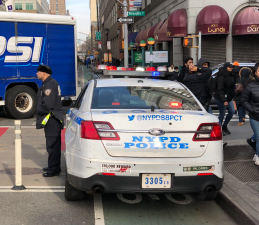Fixing Jay Street Starts With Cracking Down on Illegal Parking
Jay Street, the north-south route often overshadowed by nearby car-clogged Adams Street and Flatbush Avenue, is a major artery in the heart of Downtown Brooklyn, flush with pedestrians going to and from the subway and cyclists heading to the Manhattan Bridge. It’s also overrun with illegally-parked drivers, creating an obstacle course for anyone trying to navigate the street.

After years of advocacy by its Brooklyn activist committee, Transportation Alternatives hosted a presentation [PDF] and forum last night to solicit ideas on how to improve the street through short-term action and long-term design fixes. The event attracted nearly 100 people and included representatives from DOT and NYPD. It was co-sponsored by a suite of local groups and officials, including the Downtown Brooklyn Partnership, DUMBO BID, Forest City Ratner Companies, Community Board 2 and Council Member Stephen Levin.
“It’s been so long since it was really re-imagined. It’s outdated,” said Levin, who added that he was recently looking for a cause to champion during his second term. “Jay Street was the thoroughfare that jumped out to me as the street most in need of improvement.”
Forum leaders said cracking down on illegal parking emerged as a top issue in the five break-out groups. “The whole parking issue is really the crux of the problems on Jay Street,” said event organizer Eric McClure. The problem isn’t related to lack of available spaces nearby: The city halved off-street parking requirements in the area in part because there’s already a glut of available off-street spaces.
Dante Orsini, 67, lives in the Concord Village co-op, which sits between Jay and Adams Streets at Tillary Street and notified its residents about last night’s meeting. Orsini usually walks or drives along Jay Street and agreed that it needs fixes, especially south of Tillary. Double parking was his top complaint, he said before the meeting.
One of the hurdles to fixing the illegal parking problem: Some of the worst offenders are those who are supposed to enforce the law. A 2011 TA survey that tracked Jay Street drivers parked in bus stops, parked in the bike lane, and making illegal U-turns found that police officers comprised a big chunk of the offenders. Many of the officers are in the area to appear in court, and court-related parking abuse has long been an issue in the neighborhood.

“The parking issue emanates from the courts and I don’t know that they were represented last night, so I want to figure out how to work with them,” McClure said, adding that he would like to solicit more input from Downtown Brooklyn’s fast-growing residential population, as well as NYU-Poly and Long Island University students. “We certainly would welcome further input from the community at large,” he said.
Other proposals from the Monday forum focused on more long-term changes to the street. A popular idea, organizers said, would be to add a two-way protected bike lane and bus lanes on Jay Street, which was suggested as part of a 2010 DOT study of Downtown Brooklyn transit.
From 2002 to 2011, there were 161 pedestrian injuries and 80 cyclist injuries along Jay Street, according to data compiled by Transportation Alternatives, and there were no cyclist or pedestrian fatalities. While meeting organizers last night said they hoped the de Blasio administration would take on Jay Street as part of its Vision Zero program to eliminate traffic fatalities within a decade, they also said Jay Street needs more than just safety fixes. “This initiative shouldn’t be looked at only from a safety perspective, but from a placemaking perspective,” said planner Mike Lydon of Street Plans Collaborative, which TA hired to work on the project. “The opportunity to create a much more high-functioning street is there.”
Street Plans will release a report late this spring summarizing suggested options for Jay Street, with photo-simulations of what the street could look like. TA’s Miller Nuttle said that with a report in hand, advocates hope to work with CB 2 on a resolution asking DOT to formally study Jay Street.
“The report will be very helpful in that it gives us something concrete,” McClure said. “We’ll certainly continue to keep this issue top-of-mind for elected officials.”


